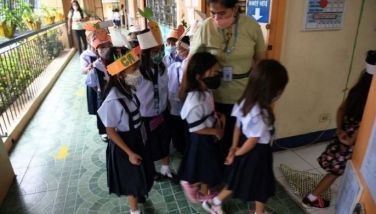Who lived at the Mehan Garden site?
August 29, 2001 | 12:00am
 Were they Chinese, Filipino, Spanish or mestizos? Were they soldiers, artisans, laborers or members of the leisurely class? When did they begin living there? When did they leave and why? How big was their community? Did they prefer imported or local goods? Were they vegetarians or meat lovers?
Were they Chinese, Filipino, Spanish or mestizos? Were they soldiers, artisans, laborers or members of the leisurely class? When did they begin living there? When did they leave and why? How big was their community? Did they prefer imported or local goods? Were they vegetarians or meat lovers?
These are some of the questions archaeologists are grappling with in view of the tremendous quantity of cultural materials excavated in the southern portion of the Mehan Garden, where the Central College of Manila (CCM) was to be erected before vehement opposition by conservationists and environmentalists forced the city government to abandon the plan.
The small excavation, only a total of 12 square meters within a total area of some 3,770 square meters, was initiated by archaeologists with the help of the private sector when it was learned that the site was to be affected, and possibly destroyed, by the construction of the CCM. The archaeologists wished to prevent past incidents where other development projects, such as the construction of a nearby mall recently, were conducted without benefit of archaeological investigation.
The artifacts in that site were totally lost after earthmoving equipment disturbed the soil matrix in which they lay preserved for centuries. To archaeologists, who reconstruct history and prehistory through the garbage and other material remains people in the past leave behind, that is like deliberately setting the National Archives on fire.
Two Spanish coins were unearthed in different levels at the Mehan Garden site, which helped archaeologists establish a date range for its occupation. Although both were abraded, they could easily be identified.
One was a copper Octavo. This coin was issued in Manila from 1771 to 1830. The other clearly had 1850 marked on it. The fact that these dates appear relatively late, considering that archaeologists in the Philippines traditionally deal with the BC and early AD eras, has led some people to comment that frolicking in the dirt for artifacts from a period for which abundant historical documents exist seems senseless.
However, it must be remembered that the historical accounts we have reflect the views of a few, and were written for a select audience, frequently in accordance with a political agenda. In addition, different groups that make up society are not represented equally in the historical record, with some sectors, such as common citizens and women, not being considered worth mentioning at all.
Archaeology can therefore fill in the gaps in the historical records and give voice to marginalized groups. More than this, however, archaeology can test the accuracy of historical accounts.
When the wreck of the Spanish galleon San Diego was investigated by archaeologists, for instance, it was discovered that there were inconsistencies between the account of its admiral, Antonio de Morga, which was preserved in our history books, and the story told by the actual wreck itself.
In the case of the Mehan Garden, historical records tell us that the site once played host to the Chinese marketplace and residential quarters known as Parian from the early part of the Spanish period to the mid to late 18th century. At this time, a number of factors, fear of the growing Chinese community included, compelled the Spaniards to transfer it to Binondo. In 1858, it was made into the Jardin Botanico de Manila. This information is confirmed in old maps. The records are mysteriously silent however, about its history from the late 18th century to the mid-19th century.
The exciting thing about the materials found at the Mehan Garden excavation is that they seem to date predominantly to the period for which not much historical data exist. Moreover, they contrast sharply with the materials found at the opposite side of the Garden, which was excavated in the 1960s.
The artifacts found in the north side for example, appear one or two centuries earlier than those found in the south side. The data recovered from the Mehan Garden excavation seem to suggest that the history of the Mehan Garden site, and of Manila in general, is far more complex than what historical records would have us believe.
At present, the excavation leaves archaeologists with more questions than answers. If Chinese artisans and traders continued to use the Mehan Garden site after it was supposedly abandoned, why was the bulk of the porcelain material recovered at the excavation of European origin? Why were luxury personal effects such as an ivory fan, tortoise shell comb and beads found in association with evidence for artillery, metal smelting devices and fishing paraphernalia? What were the wide brick pathways and adobe floors found at the site used for? How are the people at both ends of the Mehan Garden related to each other as well as to the people at Intramuros?
To answer these questions satisfactorily, archaeologists need to get down on their knees, dirty their hands some more, and literally, dig a whole lot deeper.
BrandSpace Articles
<
>
- Latest
Latest
Latest
November 30, 2024 - 5:19pm
By Joanna Perfecto | November 30, 2024 - 5:19pm
November 23, 2024 - 6:23pm
By Rupert Paul Manhit | November 23, 2024 - 6:23pm
November 23, 2024 - 1:52pm
By Edilberto de Jesus | November 23, 2024 - 1:52pm
November 14, 2024 - 7:00am
By Cielo Magno | November 14, 2024 - 7:00am
November 9, 2024 - 3:31pm
By Rupert Paul Manhit | November 9, 2024 - 3:31pm
November 2, 2024 - 5:36pm
By Venice Isabelle Rañosa | November 2, 2024 - 5:36pm
Recommended





























